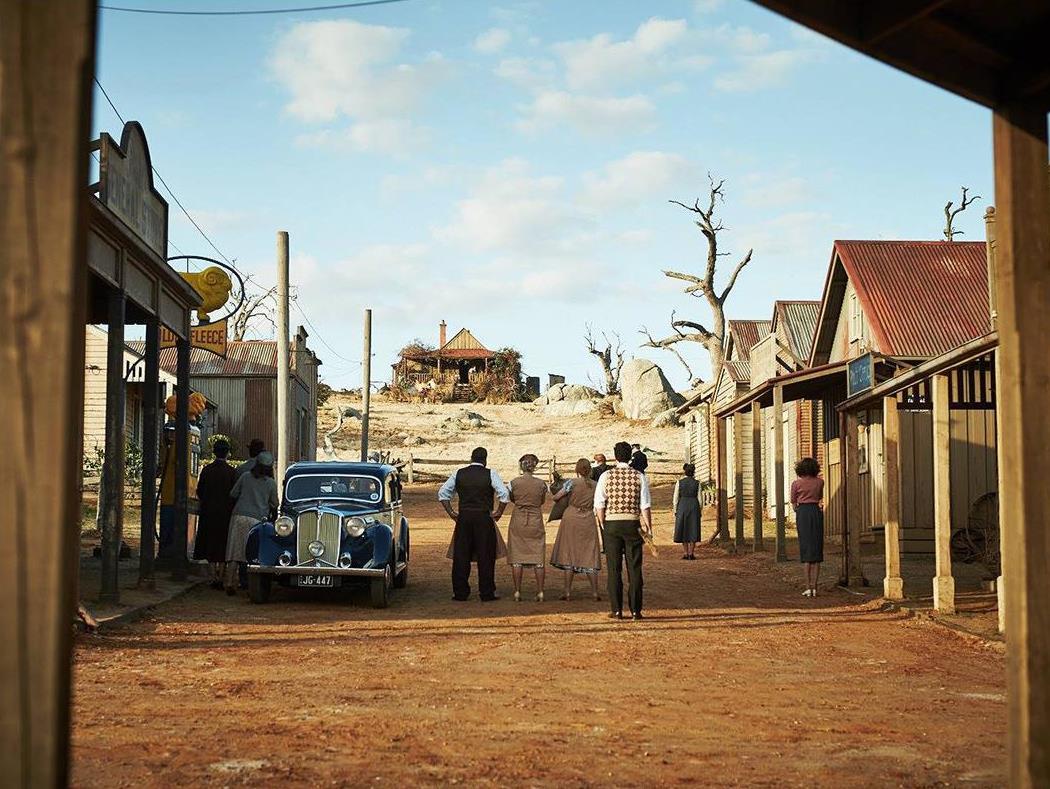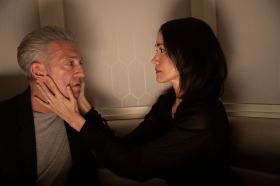Time to set the joint on fire? Image: The Dressmaker, moments before the place was burnt to the ground.
In the screen sector, the policy landscape for 2016 has been a frozen wasteland, in which nothing moves but shivering lobbyists huddling around their pitiful campfires trying to keep warm.
The biggest issue has been a piece of arcana called the 20% rule. The Tax Offset for film is 40% but only 20% for television, which creates bureaucratic and practical problems. Without getting technical, let’s jus say we could sell a lot more television drama overseas, and stop films ending up in cinemas where audiences don’t want them rather than television where they do.
So the industry keeps pushing for an even 40%, but then tells government that television drama is doing well and has great audiences etc. Treasury can see no reason to extend even more largesse to one particular industry just because it makes entertainment rather than cars.
The missing policies
With an election, there was some hope that politicians would put their hands up and take a stand. Indeed, the Greens did just that, but they were alone. On our biggest and most concrete policy issue, nothing happened.
Pretty well every other issue has been pushed off to some sort of enquiry and is languishing on the shelf. The future of games? Senate review. The sale and use of spectrum? Report gathering dust. The reach rules limiting ownership? Hidden under the bed.
Let’s not even think about regulating the international companies like Netflix and now Amazon Prime, or getting major corporations like Google to actually pay a reasonable amount of tax on their local earnings.
Almost the only thing the government has actually done is reduce the license fee which the commercial providers pay for spectrum, and plugged its ears to sector advocates who suggested that the networks might like to actually give something back in return.
We are so desperate that Mitch Fifield’s decision to allow community TV to stay on the free-to-air broadcast spectrum for an extra six months is greeted with sighs of relief.
With no external movement, the sector has turned to introspection, and here we are seeing remarkable changes which could see 2016 written into the history books.
Read more: Screen Forever – the agendas behind the program
The rise of diversity
In December 2015, Screen Australia announced its Gender Matters program, to do something about the blunt fact that women accounted for 32% of producers, 23% of writers and only 16% of directors, according to its own figures. $5m was to be spent in three years to deal with the issue via a Brilliant Stories and Brilliant Careers program, and the Distribution Guarantee Support initiative.
Women responded with 452 applications, the single biggest wave of proposals it has ever experienced. It ultimately supported the development of eighteen feature films, which is about 2/3 of a year’s slate; eleven online projects into an expanding area; and sixteen television projects which is probably more than a year’s worth of television.
The key industry conference Screen Forever ran a session in November which specifically reviewed progress on gender equity. It was opened by Courtney Gibson, who has steered Screen NSW to be the lead agency and a provocation to everyone else.
She said, ‘It is one year since the various shifts in policy were introduced in Australia. the Screen NSW gender target was announced followed by the launch of Screen Australia’s gender matters program, Screen Queensland’s gender equity measures, the SAFC gender agenda and Film Victoria’s women in leadership development initiative.
‘In NSW we’ve increased female participation overall among directors over all genres averaging out from 28% to 46% in twelve months. Writers from 30% to 48% and female producers from 56% to 67%.’
Sue Maslin, on the panel, pointed out that the financial success of The Dressmaker is a game changer. It supports her basic thesis that the argument, based on social justice, is actually about economics. A film for a female audience, unashamedly promoted with sewing, dresses and lippy, made $20.3m at the domestic box office.
It is easy for agencies to push an agenda for industry change, but they are ultimately at the mercy of the projects which come in the door. The culture of misogyny and discrimination lives across the sector, in the day to day realities of commercial decisions, the makeup of crew, the behaviour of executives and the gender of decisionmakers.
At least we are seeing a variety of non-agency organisations like the Australian Directors’ Guild, Northern Rivers Screenworks and the Natalie Miller Leadership Program take up the cudgels for attachments and internships.
Private companies involved include Endemol Shine Australia, international distributor LevelK, and Mamamia.
AFTRS has plunged in too, determined to address specific roadblocks in the development of women in crews, recognising that we are talking about a whole sector and not just the key creatives. This is culture in action.
Across 2016 we have also seen the rise of diversity as a campaign issue as well. We have seen diversity as question of culture, skin and language for a generation, which burst out with the creation of SBS. But it also has deep but unfashionable roots in organisations which have fought to see people with disabilities represented on our screens and included in our production process.
It is also growing from the sad, timid whisper which can be heard just above the floorboards in our workplaces – isn’t our industry a but, um, middle class?
Some institutions combine diversity and gender in the same bag, while others want to separate them out. Do they want to open one or two cans of worms at the same time? Screen Australia is coming to the party, but the landscape is pretty firmly owned by the Australian Film Television and Radio School at the moment, with a key report and changes to its own practices. In August Screen Australia bit off another part of the story with its Seeing Ourselves: Reflections on diversity in Australian TV drama report.
It laid out the basic numbers: 67% of Australians are Anglo-Celtic, but they comprise 82% of TV drama characters, and 76% of the actors. 18% of the population has a disability, as compared to 4% of our fantasy figures. 11% identify as LGBTQI, which comprise only 5% of our dramatic heroes. The word class is not mentioned.
The Screen Forever participants and the audiences were universally agreed that these two policy pushes need concrete action, and cannot be solved as a one-off initiative. We are talking about root and branch changes in the kinds of projects we make, the people who make them, and the leaders who define the programs and drive the culture. Without that commitment, we are in trouble.
Read more: Gender matters – maybe it won’t work
There are very positive signs. The very scale of the response and the engagement of private enterprise companies is heartening. Some of the detail is impressive. The Gender Matters projects have supported 27 new directors out of around 62 directors, and 46 new writers, from 110, so just under half of the successful applicants are making a substantial career leap, either up or sideways. New people are bringing new stories.
Read more: Gender matters picks winners and hits the ground running.
The fact that AFTRS is on board is particularly useful – and it seems that the leadership is catching up with a vision which many staff have wanted to pursue for a long time. It means that we are introducing new people into the sector, less squeezed into a middle class version of acceptable creativity, more like most of our audiences. They contain the seeds of change, and will construct – we hope – different cultures in our workplaces.
Read more: AFTRS back to the future empowered by an origin story
The best sign of all is the growth of content on the web, and the infrastructure provided by Google, Youtube, the ABC and SBS. Those shows are wonderfully different from the traditional dramas and comedies on mainstream television – exuberant, diverse and in your face. You may think this is a bit white bread…
But this is not…
.
And neither is this..
What happens next?
The signs for 2017 are very ambiguous. We could have a couple of successful features gathering audiences and plaudits, and our audiences on television are resisting the urge to fragment as the screens diversify.At the same time, we keep hearing rumours that the government is going to mount a content enquiry, which is a coded way of attacking the quotas which underpin our children’s and adult dramas. Make no mistake about it, relaxing these will reduce the amount we make, and thereby attack our capacity to develop an export market. The commercial broadcasters claim commercial imperatives will keep them in the game, but they simply make much less money out of a drama hour than a shiny floor show, and already push our series back to mid-evening.
Any more presents that can be given to the commercial providers will be gratefully received. We will see determined efforts to relax ownership regulations which will enable the industry to monopolise even further. Is it possible that Ten will disappear? Will we see changes in the anti-siphoning arrangements to make life easier for Foxtel? Would the Murdoch empire be different if Rupert leaves the business?
Perhaps the most intriguing suspense surrounds the ABC. It’s new Managing Director, Michelle Guthrie, who was CEO of Murdoch’s Star TV in Hong Kong, which was not about the public interest and didn’t aspire to quality content. She is determined to create change, and is hammering its traditional culture with demands for diversity. But she has also damaged Radio National and is removing shows which are beloved in some key communities.
Jim Rudder has been appointed on a three month contract to lead a substantial review of the ABC’s operations, along with change manager Debra Frances. He comes from Sky, Nine and Foxtel. It’s going to be a wild ride for Auntie and Guthrie’s values are difficult to read. She is certainly full of confidence and happy to defy governments, but her language at Screen Forever was short on the rhetoric of public broadcasting. It is not in her bones.
Maybe this is a clue. Go to the ABC website and look at the stories. Has the service slipped? The transcription service has been cut drastically. Why would that be?
The Guthrie watchers may seem paranoid but Shaun Brown oversaw the introduction of advertising to SBS and the drive to mainstream audiences. By the time he arrived at SBS as Managing Director, the Liberal government had let it slip a long way downhill compared to its heyday, but he did shove the body in its coffin.





